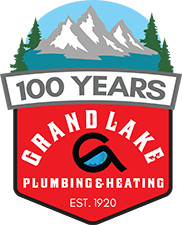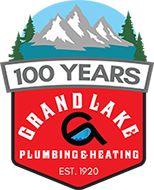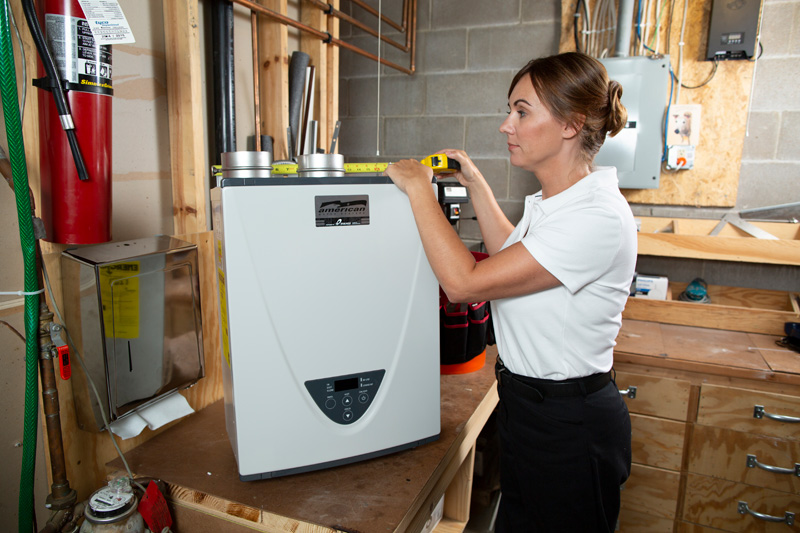
Plumbing Tips (126)
Homebuyer's Plumbing Checklist
What to Inspect Before You Buy
When purchasing a home, it's important to thoroughly inspect various systems to ensure everything is functioning correctly. Among these, the plumbing system is one of the more complex to evaluate. Here’s a comprehensive checklist to guide your plumbing inspection and ensure your future home is in top condition.
1. Inspect the Water Heater
The water heater is a key component of any home’s plumbing system. Ask the seller or realtor about the age of the water heater; most units last between 10 to 15 years. Inspect the water heater for any signs of leaks, excessive rust, or corrosion. Also, check for unusual noises, which could indicate sediment buildup or other issues. If the water heater shows signs of wear or is nearing the end of its lifespan, consider negotiating for a replacement or further inspection by a qualified plumber.
2. Check for Water Leaks
Undetected leaks can cause significant damage over time, leading to costly repairs. Carefully inspect all taps, pipes, and appliances, including dishwashers, clothes washers, and ice makers, for signs of leaks. Look for stains on ceilings, walls, or floors and check for any signs of mildew or mold, which may indicate hidden leaks. Because some leaks are not easily visible, it's advisable to hire a plumber to conduct a thorough inspection and repair any issues before closing.
3. Test the Sump Pump
Often overlooked, a properly functioning sump pump will prevent basement flooding and water damage. To test the sump pump, slowly fill the pit with water; the pump should activate and remove the water efficiently. If the pump does not turn on or struggles to drain the water, it may need maintenance or replacement. Ensure that the sump pump is in good working condition, especially if the home is in an area prone to flooding.
4. Assess the Toilets
Modern, water-saving toilets are more efficient and can significantly reduce water bills. Check to see if the toilets are newer, low-flow models that use less than 1.6 gallons per flush, as required by regulations since the late 1990s. If the toilets are older models, consider replacing them to improve water efficiency and avoid potential plumbing issues.
5. Inspect Sewer and Drain Lines
The sewer line is an often overlooked part of the plumbing system, but issues here can lead to some of the most severe problems. Ask about the age of the sewer line and whether it has been inspected within the last two years. Ensure that all drains empty quickly and smoothly; slow drains could indicate blockages or other issues. A video sewer line inspection is a worthwhile investment that can reveal potential problems like tree root intrusion, cracks, or blockages before they become significant issues.
6. Evaluate Water Pressure
Water pressure is a good indicator of the overall health of the plumbing system. Check the water flow from all faucets, showers, and outdoor spigots. Low water pressure in multiple fixtures could suggest underlying issues, such as clogged pipes or a failing pressure regulator. If you notice low water pressure, it's essential to have a plumber assess the system to identify and fix any problems.
When to Hire a Trusted Plumber
While you can perform many of these checks yourself, certain issues require the expertise of a professional plumber. If you notice any potential problems, such as leaks, low water pressure, or an aging water heater, it's best to consult with a trusted plumber before finalizing your purchase. A professional inspection can provide peace of mind and ensure that your new home’s plumbing system is in excellent condition, potentially saving you thousands in future repairs.
At Grand Lake Plumbing & Heating, we offer comprehensive plumbing inspections to help you make an informed decision on your home purchase. Our experienced plumbers will thoroughly assess the plumbing system, identify any issues, and provide the necessary repairs or recommendations to ensure everything is in good working order.
Water Heater Safety
Protecting Your Home and Family
Water heaters are used almost continuously in many homes, providing the hot water needed for bathing, cooking, and cleaning. Modern water heaters are designed with advanced safety features to ensure they operate efficiently and safely. However, understanding these safety mechanisms is essential for maintaining a safe and reliable system.
Excess Pressure and the Importance of the Temperature and Pressure Relief Valve
One of the key safety components of your water heater is the Temperature and Pressure Relief (T&P) valve. This valve is designed to prevent excessive pressure or temperature build-up within the tank. If the water temperature or pressure becomes too high, the T&P valve automatically releases water, preventing potential damage or even explosions. Regularly check your T&P valve to ensure it's functioning correctly, and replace it if you notice any signs of wear or malfunction.
Preventing Scalding to Ensure Safety for Vulnerable Household Members
Scalding can be a significant risk, especially for children and the elderly. The initial burst of hot water from the tap can be dangerously hot. To mitigate this risk, water heaters are equipped with tempering valves that mix cold water with the hot water before it reaches the tap. This ensures the water is delivered at a safer temperature, reducing the risk of burns. It's essential to set your water heater’s temperature to a safe level—typically around 120° F—to prevent scalding while still ensuring comfort and safety.
Bacteria Prevention By Keeping Your Water Heater at the Right Temperature
While it's essential to avoid scalding, keeping your water heater's temperature too low can lead to other dangers, such as bacterial growth. Legionella bacteria, which causes Legionnaire's disease, can thrive in water temperatures that are too low. To prevent the growth of bacteria in your water heater, maintain the temperature at or above 122° F. Regular maintenance and temperature checks can help keep your water safe and free from harmful bacteria.
Backflow Protection To Ensure Clean and Safe Water
Backflow occurs when non-potable water or wastewater flows back into the clean water supply, usually due to changes in system pressure. This can lead to contamination of your drinking water. Water heaters are typically equipped with a one-way valve to prevent backflow. In some cases, a pressure overflow tank is also used to manage pressure fluctuations. Regularly inspect these components to ensure they are functioning correctly, protecting your home from potential contamination.
When to Hire a Trusted Plumber
While modern water heaters are designed with safety in mind, issues can still arise that require professional attention. Here are some signs that it’s time to hire a trusted plumber from Grand Lake Plumbing & Heating:
- Strange Noises – If your water heater is making unusual sounds, such as banging, popping, or hissing, it could indicate sediment build-up or other internal issues.
- Leaks – Any visible water around the base of the water heater is a clear sign that something is wrong and requires immediate professional inspection.
- Inconsistent Water Temperature – If your hot water is suddenly too hot, too cold, or fluctuating in temperature, it may be a sign of a failing thermostat or other issues.
- Discolored Water – Rusty or discolored water coming from your taps could indicate corrosion inside your water heater tank.
- No Hot Water – If your water heater isn’t producing hot water at all, it’s time to call a professional.
Dealing With Low-Flow Toilet Woes
Tired of Two-Flushing?
You've probably heard that a new Colorado law took effect in September 2016, requiring all new toilet installations in the state to be certified as water-efficient and meet federal WaterSense standards. WaterSense certification ensures that plumbing fixtures use at least 20 percent less water. For toilets, this means using 1.28 gallons of water or less per flush, compared to the federally mandated maximum of 1.6 gallons per flush.
While low-flow toilets can save up to 13 billion gallons of water annually in Colorado alone, they can also present a few challenges. With less water available per flush, you might find yourself needing to flush more than once due to the reduced flushing power. This defeats the purpose of having a low-flow toilet and should be avoided. In this post, we'll explore some common issues with low-flow toilets and provide practical solutions to help you make the most of your water-efficient fixture.
Common Issues and Solutions for Low-Flow Toilets
Underfilled Toilet Tank
One common issue with low-flow toilets is an underfilled tank. When the tank doesn't have enough water, the flush may be weak, necessitating multiple flushes. To address this:
Check the Fill Valve Setting
Refer to the manufacturer's instructions for setting the fill valve. Ensure the water in the tank is at the correct level. Many tanks have a fill line to guide you. If there is no fill line, a good rule of thumb is to keep the water level about half an inch below the top of the overflow tube inside the tank.
Adjust the Float
If the water level is too low, adjust the float. This is often a simple process involving turning a screw on the fill valve to raise the water level in the tank.
Flapper Chain Tension
Another issue could be the tension on the flapper chain. If the chain is too loose, the flapper won't open fully when you flush, preventing the tank from emptying completely.
Here's how to fix it:
- Open the Tank - Remove the lid from the toilet tank.
- Check the Chain Slack - The chain should have just a little slack. If it's too loose, adjust the length by hooking the chain onto a different link.
- Test the Flush - After adjusting the chain, test the flush to ensure the flapper opens fully and the tank empties properly.
Mineral Buildup
Colorado is known to have hard water. This mineral buildup can affect the performance of low-flow toilets, particularly in areas with hard water. Over time, mineral deposits can clog the small holes under the rim of the toilet bowl, reducing water flow and flush efficiency.
Clean the Rim Holes
Use a wire hanger or a specialized cleaner to clear any mineral deposits from the holes.
Regular Maintenance
Regularly cleaning your toilet with a descaling cleaner can help prevent mineral buildup and maintain optimal performance.
Benefits of Low-Flow Toilets
Despite the occasional issues, low-flow toilets offer significant benefits:
Water Conservation
By using less water per flush, low-flow toilets help conserve water, which is crucial in areas prone to drought and water scarcity.
Cost Savings
Reduced water usage translates to lower water bills, providing long-term savings.
Environmental Impact
Conserving water helps protect Colorado's natural resources and reduces the strain on municipal water systems.
When To Call Grand Lake Plumbing & Heating For Help
If you're still experiencing issues with your low-flow toilet, or you have any other plumbing concerns, don't hesitate to contact Grand Lake Plumbing & Heating. Our team of experienced plumbers is here to help with all your plumbing needs. Whether it's a simple adjustment or a more complex repair, we're dedicated to providing top-notch service to ensure your plumbing systems operate efficiently and effectively.
More...
Water Heater Inspection Checklist
A comprehensive guide to keeping your water heater working safely and efficiently
Whether you’re buying a new home or maintaining your current one, keeping your water heater in optimal condition is important for maintaining a reliable, efficient source of hot water. Water heaters typically last between 10-15 years, but regular inspections can help you avoid costly repairs and ensure your maximize the lifespan of the unit. Here’s a comprehensive checklist from the experienced plumbers at Grand Lake Plumbing & Heating to help you evaluate your water heater’s condition and performance.
1. Consistent Hot Water Production
Ensure that your water heater consistently produces hot water. Sudden drops in hot water supply might indicate issues with the burner or sediment buildup in the tank. Regular maintenance, including draining the tank annually, can help prevent these problems.
2. Unusual Noises
Listen for any unusual sounds coming from your water heater. Gurgling or popping noises often signify sediment accumulation at the bottom of the tank. Flushing the tank periodically can help prevent sediment buildup and prolong the heater’s lifespan.
3. Burn Marks at the Base
Inspect the base of the water heater for any burn marks. These can be a symptom of back drafting, a serious safety issue that requires immediate attention from a professional plumber. It's important to address this promptly to prevent potential hazards such as carbon monoxide poisoning.
4. Proper Ventilation
Check for proper ventilation to ensure the safe operation of your water heater. Make sure the draft hood is securely connected and that the flue is properly attached with at least three screws per joint. If the flue runs into a chimney, it should be correctly lined and connected to prevent carbon monoxide from re-entering your home.
5. Is There a Drain Pan?
If your water heater is located on an upper level of your home, a drain pan can prevent water damage. It helps contain and safely drain leaks to prevents water damage to floors and ceilings below. This simple addition can save you from significant repair costs in case of a leak.
6. Drip Pipe and Pressure Relief Valve
Ensure that the temperature and pressure (T&P) relief valve has a drip pipe extending to within six inches of the floor. This pipe is required for safely discharging excess pressure and preventing potential water heater pressure damage. Check that the pipe is not leaking and is securely attached.
7. Check the Anode Rod Condition
Inspect the condition of the anode rod, an important component in preventing tank corrosion. Anode rods attract corrosive elements in the water, protecting the steel liner of the tank. Replacing a worn anode rod can significantly extend the life of your water heater.
8. Regular Maintenance
Regular maintenance is key to extending the life of your water heater. Schedule annual inspections with a professional plumber to ensure all components are functioning correctly. Routine maintenance includes flushing the tank, checking the anode rod, and ensuring proper ventilation and safety features are in place.
9. Check for Leaks
Look for any signs of leaks around the water heater. Even small leaks can indicate bigger problems and should be addressed immediately to prevent water damage and further deterioration of the unit.
10. Evaluate the Age of the Water Heater
Know the age of your water heater and plan for replacement if it’s approaching the 10-15 year mark. Older units are more prone to failure and less energy-efficient, so upgrading to a newer model can save you money in the long run.
The Importance of Home Plumbing Maintenance
Regular inspections and maintenance are essential to keep your water heater functioning properly and efficiently. By following this comprehensive checklist, you can identify and address potential issues before they become costly repairs. A well-maintained water heater not only ensures a steady supply of hot water but also contributes to the overall safety and comfort of your home.
When to Call Grand Lake Plumbing & Heating For Service
If you encounter any issues or are unsure about the condition of your water heater, it’s best to consult a professional plumber. At Grand Lake Plumbing & Heating, we offer expert water heater inspections and maintenance services. Our experienced technicians can help you identify and resolve any potential problems, ensuring your water heater operates safely and efficiently.
For over 100 years Grand Lake Plumbing & Heating has been dedicated to providing top-quality service in Grand County to keep plumbing systems in excellent condition. Call us today to schedule an inspection or learn more about our hot water services.
Use Chemical Drain Cleaners With Caution
The Risks of Using Drain Cleaners: What You Need to Know
Having chemical drain cleaners in the home can be helpful for some types of clogs, but there are also risks you should be aware of to protect your family's safety and prevent damage to your home.
What's In Chemicals in Drain Cleaners?
Liquid drain cleaners commonly contain corrosive chemicals such as alkaline, bleach, and lye in high concentrations. They work by dissolving organic matter such as food waste, hair, grease, and more. The effectiveness of chemical drain cleaners depends on how far the clog is from the drain opening. Generally, the further away it is, the less effective the liquid cleaners will be. This is why liquid drain cleaners are rarely effective for clogged toilets.
Chemical Drain Cleaner Safety Tips
Drain cleaners are among the most hazardous household products in the home. To reduce the risk of injury, follow these safety tips:
- Read and Follow Instructions: Always read the label and follow the instructions carefully.
- Proper Storage: Store the container in a safe location out of reach of children and pets.
- Avoid Contact with Certain Materials: Because liquid drain cleaners are highly corrosive, avoid contact with materials such as wood, paint, fiberglass, and aluminum.
- Protect Yourself: Always wear rubber gloves and protect your eyes when handling drain cleaners.
The Safe and Effective Alternative: Professional Drain Cleaning
The safest and most effective alternative to chemical drain cleaners is to have your drains professionally cleaned. Physical methods such as using a drain snake or water jetting are highly effective at removing the toughest clogs from sewer and drain lines. Here’s why you should consider professional drain cleaning:
- Complete Removal of Obstructions: Professional tools can reach clogs that liquid cleaners can't, ensuring a thorough cleaning.
- Safety: No need to handle dangerous chemicals.
- Preventing Damage: Professional cleaning prevents potential damage to your plumbing system that can be caused by corrosive chemicals.
- Long-Term Solution: Professional cleaning can help prevent future clogs, keeping your drains running smoothly for longer.
By choosing professional drain cleaning services, you’ll have peace of mind knowing the job is done right without the risks associated with chemical cleaners.
For reliable and safe drain cleaning services in Grand Lake, Colorado, contact Grand Lake Plumbing & Heating today. Our experienced technicians are equipped with the latest tools and techniques to keep your drains clear and your home safe. Call us now to schedule an appointment and experience the best in professional drain cleaning.
Tips to Improve the Performance of Your Water Heater
Tank-style water heaters are among the most energy-hungry appliances in the home, often second only to heating and cooling systems. By changing some habits and installing a few simple accessories, you can significantly reduce the energy consumption of your water heater. Here are some tips to help improve its performance:
Reduce Hot Water Usage at the Source
One of the easiest ways to cut hot water usage is to install water-saving showerheads. The maximum flow rate for a showerhead should be no more than 2.5 gallons per minute (gpm). Many water-conserving showerheads can reduce flow to as little as 1.6 gpm while maintaining acceptable water pressure. For a household of four, this could save up to 14,000 gallons of water a year, significantly reducing the energy required to heat the water.
Insulate the Hot Water Distribution System
Even in a small home, up to 10 percent of the energy used to heat water can be lost through the pipes that supply the hot water. Insulating hot water pipes is an inexpensive way to significantly reduce heat loss. This simple step can improve the efficiency of your water heater and ensure hot water is delivered more quickly to your faucets and showers.
Use a Water Heater Blanket
While many new water heaters have sufficient insulation built into the tank wall, older tanks may allow heat to escape. The larger the water heater, the more surface area there is for heat to escape. Prevent heat loss by wrapping your water heater tank in an insulation blanket available from most home supply stores. Some manufacturers recommend against installing insulating blankets on their energy-efficient models, so be sure to read your owner's manual before adding a blanket.
Perform Regular Water Heater Maintenance
Over time, storage tank water heaters can accumulate sediment, reducing heating efficiency. Flushing the tank annually will remove the sediment and make it easier for the burner or heating element to heat the water. Additionally, checking the anode rod and replacing it if necessary can help prevent tank corrosion and extend the life of your water heater.
Lower the Thermostat Setting
Many water heaters are set to 140 degrees Fahrenheit by default, but most households can more safely and comfortably use water heated to 120 degrees Fahrenheit. Lowering the thermostat setting not only reduces the risk of scalding but also cuts down on energy consumption and slows down mineral buildup in the tank.
Consider Upgrading to a More Efficient Model
If your water heater is over 10 years old, it might be time to consider replacing it with a more energy-efficient model. Tankless water heaters, for example, provide hot water on demand and can save a significant amount of energy compared to traditional tank-style water heaters. Look for models with the ENERGY STAR® label for the highest efficiency.
Install a Water Heater Timer
For households that use a water heater on a set schedule, installing a timer can help reduce energy consumption. A timer can turn the water heater off during periods of low demand, such as during the night or while you're at work, and turn it back on just before you need hot water.
Have water heater questions? Give Grand Lake Plumbing & Heating a call. Our experts are here to assist you with all your water heater needs, from maintenance and repairs to installations and upgrades. Call or email us today!
How to Quiet Noisy Pipes
How to Quiet Noisy Pipes
Rattling, banging, and squeaking pipes can not only drive you crazy but also lead to major problems. If left unchecked, loose pipes can disconnect from mounting brackets, stressing the pipe and causing a leak. Here’s how you can quiet those noisy pipes and prevent further issues.
Identifying Common Pipe Noises
Water Hammer
If you hear a banging noise when turning the water on and off, water hammer is the likely cause. Water hammer occurs when the water chamber that normally cushions the water pressure becomes filled with water. The condition can usually be fixed by draining the pipes in the home to restore the chambers with air.
How to Fix Water Hammer:
- Shut off the main water valve and open all faucets in your home to drain the pipes.
- Once the water is completely drained, close the faucets and turn the main water valve back on.
- The air chambers should now be filled with air, cushioning the water pressure and eliminating the banging noise.
Rattling Sounds
Rattling noises often indicate that your pipes are not securely anchored to the wood joists. Loose anchoring brackets can cause the pipes to vibrate and make noise.
How to Fix Rattling Pipes:
- Inspect the pipes to ensure they are securely anchored to the wood joists.
- Tighten any loose brackets to secure the pipes firmly in place.
- If the brackets are damaged or missing, replace them with new ones to ensure a secure fit.
Vibration Noises
As pipes pass through holes in joists, they can come into contact with the wood framing. This contact can cause vibration noises.
How to Fix Vibration Noises:
- Identify the points where the pipes pass through the joists and make contact with the wood.
- Wrap the pipes with foam insulation or rubber padding to dampen the movement and reduce the noise.
- Ensure the insulation is snug enough to prevent the pipes from vibrating against the wood framing.
Squeaking Pipes
Metal hot water pipes can expand and contract as the water temperature changes, causing them to rub against metal mounting straps. This can create squeaking noises.
How to Fix Squeaking Pipes:
- Locate the metal mounting straps where the noise is occurring.
- Add foam or rubber cushioning around the mounting straps to prevent the metal pipes from rubbing against them.
- Ensure the cushioning is secure and covers all points of contact between the pipes and the straps.
Additional Tips for Quieting Noisy Pipes
- Check for Loose Pipe Straps: Regularly inspect your plumbing system for loose or damaged pipe straps and replace them as needed.
- Install Water Hammer Arrestors: If water hammer is a recurring issue, consider installing water hammer arrestors. These devices can absorb the shock and prevent the banging noise.
- Use Pipe Clips and Clamps: Ensure all pipes are secured with appropriate clips and clamps, especially in areas where they pass through walls and floors.
- Regular Maintenance: Schedule regular plumbing maintenance to identify and address potential issues before they become major problems.
Need Professional Help?
Have questions about plumbing noises in your home? Call Grand Lake Plumbing and Heating. We can help with all your plumbing needs. Our experienced technicians are equipped to handle any plumbing issue, ensuring your home remains quiet and leak-free.
3 Tips to Make Your Water Heater Last Longer and Work More Efficiently
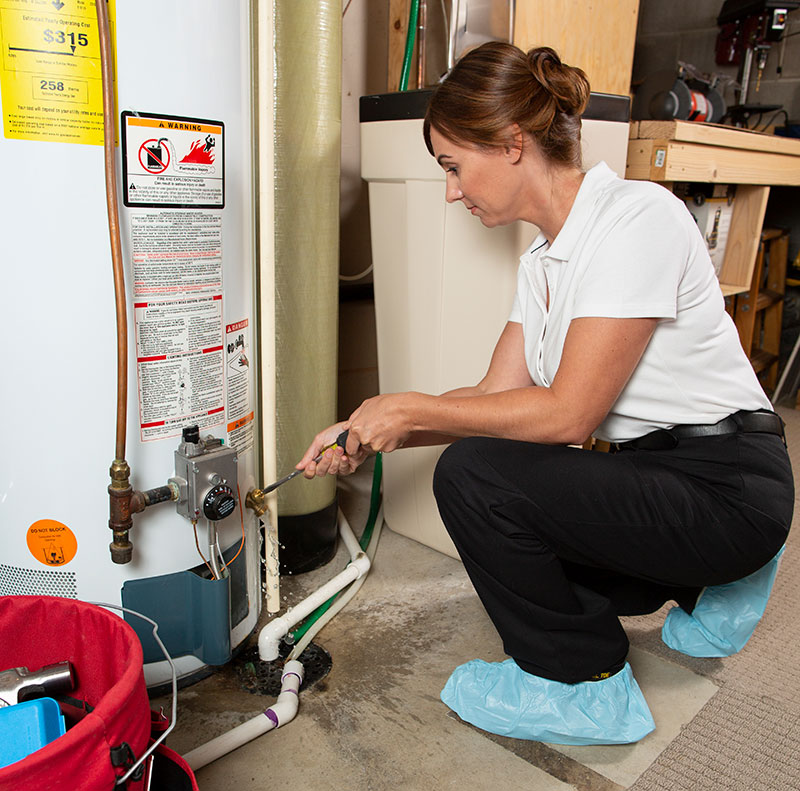
Many homeowners invest in a conventional tank water heater and often overlook it until it malfunctions or completely fails – often prematurely. However, adopting a few simple maintenance practices can not only extend the lifespan of your water heater but also enhance its efficiency. At Grand Lake Plumbing & Heating in Grand County, we recommend the following essential tips to keep your water heater in optimal condition.
Water Heater Maintenance Tips:
Annually Flush Your Water Heater Tank
Most manufacturers advise flushing your water heater tank each year. This process involves draining the tank to eliminate any sediment that has accumulated at the bottom. Removing this sediment is crucial as it ensures that the heating element can operate more efficiently, thereby reducing heating time and energy consumption.
To properly drain your water heater, refer to the manufacturer’s specific instructions for your model. This will ensure that you perform the flush properly and safely. If you prefer, Grand Lake Plumbing and Heating can flush the tank for you.
Inspect and Replace the Anode Rod as Needed
The anode rod is an important component of your water heater, designed to prevent the internal corrosion of the tank. This rod should be inspected annually—preferably during the tank's flushing process. If you find the anode rod to be significantly corroded, replacing it is generally more cost-effective than risking irreversible corrosion damage to your water heater.
A functional anode rod significantly prolongs the life of the water heater by preventing the rapid corrosion of the tank’s interior due to hot water exposure.
Insulate Your Water Heater Tank
Insulating your water heater tank is a one-time action that can boost its efficiency significantly. A water heater blanket wraps around your tank, reducing the heat lost to the surrounding environment. This means less energy is needed to maintain the water temperature, thereby enhancing overall efficiency.
Be sure to use a product specifically designed for insulating water heaters and install it properly to avoid blocking access to controls and ventilation.
Bonus Tip: Reduce Your Hot Water Usage
Although not directly maintenance related, minimizing hot water usage can decrease the demands on your water heater, leading to a longer lifespan and reduced maintenance needs. Installing low-flow showerheads and opting for cold water settings when washing clothes can significantly cut down hot water use.
Have questions about maintaining your home's water heater? Contact Grand Lake Plumbing & Heating—we have over 100 years of experience servicing hot water systems.
Spring Home Plumbing Maintenance Tips
Springtime in Grand County, Colorado, brings not just the beauty of blooming alpine flowers and melting snow but also the need for homeowners to ensure their plumbing systems are ready for the warmer months ahead. At Grand Lake Plumbing & Heating, we understand the unique challenges our climate can present for our home's plumbing systems. That's why we've compiled a comprehensive spring plumbing checklist for you. Following this guide will help ensure your home’s plumbing system functions smoothly, saving you from unexpected repairs and costs.
Check for Leaks
Inspect all exposed pipes under sinks and in the basement for signs of leaks. Look for puddles, water stains, or mold. A common cause of leaks is frozen pipes that have cause undetected damage.
Test Your Sump Pump
Spring thaw can put your sump pump to the test. Pour a bucket of water into the sump pit to ensure it's working correctly. Listen for any unusual noises and ensure the water is being ejected away from your home.
Ensure Plumbing Systems Are Regularly Used
If your home is unoccupied for significant periods of time, remember to exercise faucets, toilets and water valves under sinks and toilets will prevent them from sticking and keep them in good condition.
Water Heater Maintenance
Drain and flush your water heater to remove sediment buildup, which can reduce efficiency and lifespan. Check the temperature setting (120°F is ideal for energy efficiency and safety).
Inspect Toilet Flappers and Fill Valves
Leaky toilets can waste a significant amount of water. Check for signs of wear or breaks and test for silent leaks by adding a few drops of food coloring to the tank and waiting to see if the color appears in the bowl.
Check for Hard Water Buildup
Grand County's water can be hard, leading to mineral buildup in your fixtures and appliances. Soak shower heads and faucets in vinegar to remove deposits. If hard water is a concern, consider installing a water softener or reverse osmosis water filtration system.
Inspect Outdoor Faucets and Hose Bibs
After a cold Grand County winter, checking for freeze damage is crucial. Turn on each outdoor faucet to ensure water flows freely and closes securely without leaks.
When to Call a Professional Plumber
While many spring plumbing tasks can be DIY, there are times when calling in a professional plumber from Grand Lake Plumbing & Heating is the best course of action:
Major Leaks or Burst Pipes
If you discover significant leakage or suspect a burst pipe, it's important to call a professional immediately to prevent further damage.
Sewer Line Issues
If you notice foul odors, slow drains throughout the house, or water backing up, you might have a sewer line problem. These issues require professional equipment and expertise.
Water Heater Problems
If your water heater is leaking, making strange noises, or not providing enough hot water, it's time for a professional inspection. Water heaters can be complex and potentially dangerous to work on without proper training.
Installation of New Fixtures or Appliances
To ensure proper installation and avoid future problems, have a professional handle the installation of new plumbing fixtures or water-using appliances.
Remodeling Projects
Any plumbing involved in kitchen, bathroom, or basement remodeling should be handled by a professional to ensure it meets local building codes and standards.
At Grand Lake Plumbing & Heating, we're here to ensure your plumbing system is in top condition for spring and beyond. Whether you need help with routine maintenance winterization, repairs, or emergencies, our team of experienced professionals is just a call away.
Choosing the Best Garbage Disposal
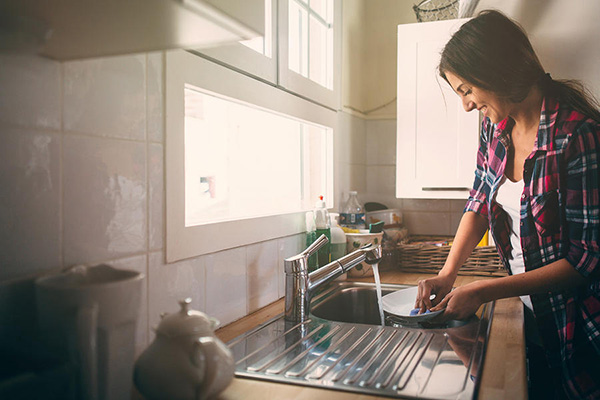
Time to replace your old under sink garbage disposal? Choosing the right garbage disposal can make a world of difference in your kitchen's functionality and efficiency. With so many models, brands, and features available, the selection can be overwhelming. There are a number of factors to you'll want to consider, including durability, noise levels, price, and brand reputation.
Here's a guide to help you make an informed decision and choose the best disposal for your needs.
Types of Garbage Disposals
There are mainly two types:
Continuous Feed
The most common type, it operates as long as the switch is on. It's user-friendly, but ensure you run water during the process to prevent jamming.
Batch Feed
As the name implies, this type allows you to put food waste in all at once, typically around 5 cups,. It usually requires a cover to operate, ensuring safety as it won’t run until it's securely in place. The cover makes it a good choice for households with children.
Horsepower
1/3 Horsepower is the starting point for disposals, offering the lowest power and lowest cost. While they can seem like a bargain, we recommend avoiding low-power disposals. They will be more prone to jamming and are often made from lower quality components that wear out more quickly.
1/2 horsepower garbage disposals are the minimum rating recommended for a home disposal. They are widely available, affordable and compact enough to fit in tight spaces. If you don't use a disposal that often and don't mind the higher noise levels of a smaller disposal, a 1/2 horsepower unit may be a good option. Choose a disposal with stainless steel grinding components, they will resist rusting and wear and tear longer, increasing the lifespan of the unit.
For many households, a 3/4 horsepower disposal will work best. They have plenty of power to handle those large holiday gatherings and can safely grind potato peels, celery and more without complaint. While they require more space under the sink than lower power units, they are typically quieter.
Have a large family or do a lot of cooking and entertaining? Consider upgrading to a 1 horsepower disposal. They can handle just about anything you can throw at them. With a large grinding chamber and premium stainless steel components they make quick work of everything from chicken and fish bones to fruit rinds.
1 horsepower units are the top-of-the-line, just make sure you have the room under your sink!
Whatever size unit you decide to purchase, it's important to always run lots of water when grinding waste to ensure that residue does not build up inside the girding chamber.
Have questions about selecting the right garbage disposal for your kitchen? Call Grand Lake Plumbing & Heating. We can help you choose the right disposal for your needs.
Water Heater Troubleshooting Guide
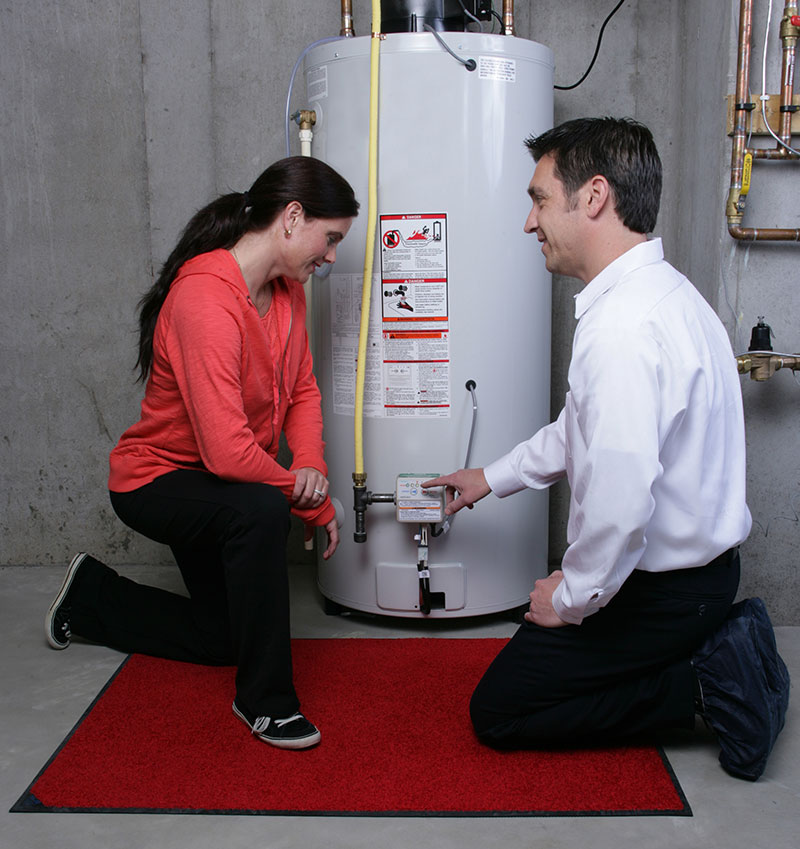
Most of us havel faced it—a chilly morning shower, strange noises from the water heater, or an unexpected spike in the utility bill. But did you know that most water heater problems have simple solutions? We have put together a troubleshooting guide to help with the most common issues you are likely to encounter.
No Hot Water
Possible Causes:
- Tripped circuit breaker
- Faulty thermostat
- Malfunctioning heating element
Solutions:
- Reset the circuit breaker
- Check and replace the thermostat if necessary
- Inspect the heating element. If damaged, the water heater will need to be replaced
Running Out of Hot Water
Possible Causes:
- Undersized water heater for your home's needs
- Sediment build-up at the bottom of the tank
- Broken or malfunctioning dip tube
Solutions:
- Consider upgrading to a larger capacity heater
- Drain and flush your heater to remove sediment
- Check and replace the dip tube if damaged
Water Discoloration
Possible Causes:
- Rusty anode rod
- Sediment accumulation in tank
- Poor water quality
Solutions:
- Replace the anode rod
- Drain and flush the tank to remove sediment
- Have your home's water tested for excessive iron or other contaminents
Bad Water Taste
Possible Causes:
Old tank or decaying anode rod
Bacterial contamination for low tenk temperature
Solutions:
Check and replace the anode rod.
Disinfect your tank with a bleach solution and flush thoroughly.
Water Heater Noises
Possible Causes:
- Sediment build-up causing popping or rumbling
- Expansion and contraction of heating elements
Solutions:
- Drain and flush your heater to clear out sediments
- If the noise persists, consult a plumber
High Utility Bills
Possible Causes:
- Inefficient or old water heater model
- External leaks or damaged insulation
Solutions:
- Consider upgrading to a more energy-efficient model
- Check for leaks and repair. Insulate the heater and pipes to conserve energy
Water On Or Around Water Heater
Possible Causes:
- Leaky valves
- Tank corrosion or damage
Solutions:
- Inspect valves and tighten or replace as necessary
- If the tank is corroded, it's time for a replacement
If you're experiencing water heater problems, call Grand Lake Plumbing and Heating. Our experienced plumbers can quickly diagnose the problem and recommend solutions for repairs or, when needed, water heater replacement.
A Step By Step Guide to Buying a New Water Heater
Expert Hot Water Tips for Homeowners
Water heaters are essential home appliances we rely on all day long, but they aren’t something we think about until they malfunction and the hot water tap runs cold. If you’re in the market for a new one, this guide will help you make the right choice for your home. Let's dive right into it!
Why is Choosing the Right Water Heater Important?
Water heaters aren’t just about getting hot water. Choosing the right unit impacts your energy bills and ensures you get a consistent supply of hot water whenever you need it. As you'll see below, there are different types of water heaters for different needs.
Step 1: Determine Your Needs
Evaluate Your Daily Hot Water Usage
Estimate how much hot water your household uses daily. Consider the number of people, daily routines, and peak times for water usage.
Understand Your Home's Infrastructure
Is your home set up for gas, electric, or both? The infrastructure will dictate the type of heater you can install.
Step 2: Choose the Type of Water Heater
Storage Tank Heaters
The most common type. They consist of an insulated tank where water is heated and stored until needed.
Tankless Water Heaters
These heat water directly without using a storage tank. They’re energy-efficient but might not be the best for large families.
Heat Pump Heaters
Rather than generating heat directly, they move heat from one place to another. These are best for homes in warmer climates.
Step 3: Look at Energy Efficiency Ratings
Higher energy efficiency means lower monthly bills. Check the Energy Guide label on the unit. It can provide estimated yearly operational costs and compare its efficiency with other models.
Step 4: Decide on the Right Size
For Storage Tank Heaters
Choose a unit based on the number of gallons the tank holds and how quickly it heats the water.
For Tankless Heaters
Look at the gallons-per-minute (GPM) rate. Ensure it can handle your household's peak demand.
Step 5: Consider the Warranty
Most water heaters come with warranties ranging from 3 to 12 years. While a longer warranty is better, it might also mean a slightly higher price.
Step 6: Factor in Installation Costs
Remember, the purchase price of your heater isn’t the only cost. Installation can vary depending on the complexity of the job. Tankless water heaters are typically more costly to install.
Choosing a new water heater might feel overwhelming, but by starting with the questions above you'll have a head start when hiring a plumber to replace your water heater.
Bathroom Renovation: Essential Plumbing Tips & Considerations
Bathroom Renovation: Plumbing Considerations to Keep in Mind
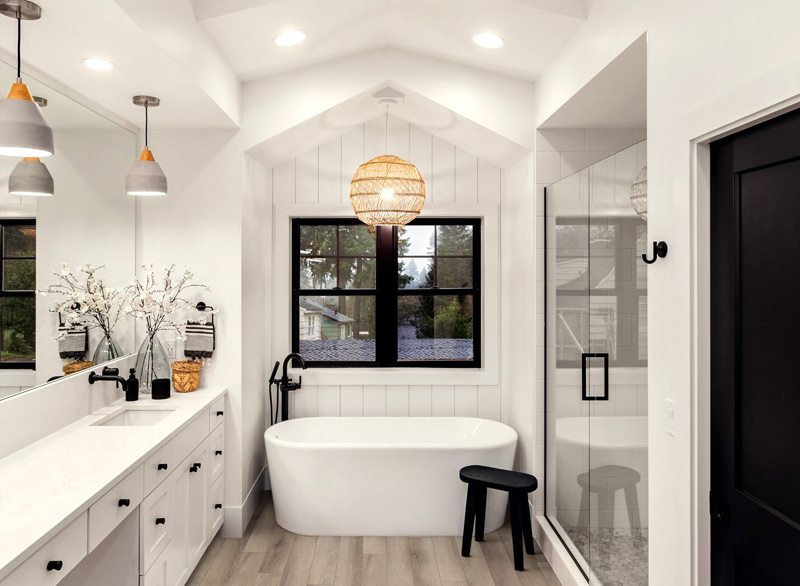
Bathroom renovations not only enhance the aesthetic appeal of your home but can also significantly increase its resale value. While it's easy to get caught up in choosing the right aesthetic, such as the perfect tiles or fixtures, it's important to not overlook underlying the plumbing system. Not upgrading the plumbing can lead to long-term issues. In this article, we'll take a look at the crucial plumbing considerations you should bear in mind when remodeling your bathroom.
Assessing the Existing Plumbing System
Checking for Old Pipes
Before you start any renovation, it’s imperative to have a professional plumber inspect your existing plumbing. Older homes often have galvanized or lead pipes, which might need replacement due to corrosion or health concerns.
Testing Your Water Pressure
It's also important to test your home's water pressure. If it’s too high, it can damage your fixtures and pipes. On the other hand, low water pressure might indicate blockages or leaks. If you have a well, it's important to have your pressure tank inspected to ensure it is working correctly and maintaining optimum pressure.
Choosing the Right Fixtures
Selecting Water-Efficient Models
Modern fixtures, like low-flow toilets and faucets, can save a significant amount of water without compromising on functionality. Look for shower heads, toilets and faucets with the WaterSense label
Ensuring Compatibility with Existing Plumbing
Ensure that the fixtures you choose are compatible with your home's plumbing system. For example, some luxury shower heads with multiple spray systems may require a specific water pressure range to function optimally.
Your plumber must ensure that the fixture's inlet matches the size of your existing pipes. If there's a mismatch, it might lead to reduced water flow or leaks. The material of your pipes must also be considered. When combining PVC pipes with copper fixtures the appropriate connectors must be used to ensure compatibility.
Venting and P-Trap Placement
When relocating fixtures, remember that each one will need proper venting and a correctly positioned P-trap to prevent sewer gases from entering your home.
Other Potential Challenges
Space Limitations
In smaller bathrooms, you might face limitations when positioning fixtures and ensuring that they have the required spacing. By work closely with a plumbing expert you can ensure that your needs are met while limiting compromises.
Future-Proofing Your Plumbing
Anticipating Future Needs
Think about your houshold's potential future needs. Will your family be growing? Are you planning on aging in place? Consider accessible fixtures that are easy to operate, have anti-scald devices and ensure there is easy access for walk-in showers during your renovation.
Hiring a Professional Plumber
While DIY can lead to the satisfaction of a job well done, it can also be a path to disappointment when things don't go as expected. Before making any decisions, get an expert's opinion. A plumber can guide you on what fixtures will work best with your existing plumbing and help make sure that systems are up to code.
While the design and aesthetics of your bathroom renovation are what homeowners focus on, it's the underlying plumbing that can make or break your bathroom remodeling project. The experienced plumbers at Grand Lake Plumbing are here to answer all your questions and can help ensure a successful, problem-free bathroom remodel.
Environmentally Friendly Ways To Keep Your Drains Clean
Avoid Harsh Chemical Drain Cleaners With These Safer DIY Alternatives

Ever read the warning labels on a container of store bought drain cleaner? You'll find chemicals like lye, sodium hypochlorite, sodium nitrate, sodium sulfate and more.
While these ingredients can be highly effective, they're also corrosive and can cause skin and eye irritation or damage if not handled very carefully. They can also be harmful if inhaled or ingested, so it's crucial to use these products away from young children and pets.
These common drain cleaning chemicals can also be damaging to the environment and the water supply, so it's important to use them responsibly and sparingly. Or, better yet, why not try a safer, environmentally save alternative the next time you have a minor clogged drain?
Baking Soda and Vinegar: This is a classic, natural method that works on small clogs. Pour half a cup of baking soda down the drain, followed by half a cup of vinegar. Wait 15-20 minutes and then rinse with hot water.
Hot Water and Dish Soap: For grease clogs in the kitchen, you can try hot water and dish soap. Pour a good squirt of dish soap down the drain, followed by a pot of boiling water. This can help loosen and dislodge grease clogs.
Salt, Borax, and Vinegar: Mix 1/4 cup of salt, 1/4 cup of borax, and 1/2 cup of vinegar, and pour it down the drain. Let the mixture sit for about an hour, then rinse it away with hot water. This can help dissolve some types of clogs and prevent the growth of bacteria in your pipes.
Enzyme-based Drain Cleaners: Enzyme-based drain cleaners, like Bio-Clean Drain Septic Bacteria or Earthworm Drain Cleaner, use natural enzymes or bacteria to break down clogs. They're a safer option for your pipes and for the environment, but they might take longer to work compared to chemical cleaners.
It's important to remember that even these environmentally friendly methods need to be used with care. Avoid overusing them or using them on large or persistent clogs, as this could potentially damage your pipes over time. And always remember, if a clog persists or keeps returning, it's best to call in a professional plumber. Professional drain cleaning can remove the toughest clogs and remove the residue deep inside the drain lines that can cause clogs to keep reforming.
Important Questions to Ask Before Hiring a Plumber

We often don't think about our home's plumbing system until things go wrong. When there's a major leak, a backed up drain, or other issue, and you need to find a plumber fast. To ensure you're hiring the right plumbing company for the job, it's important to ask potential plumbers a few key questions. Here are some of the most essential ones to consider:
Are You Licensed?
This is the first and foremost question you should ask. A licensed plumber has met all state and local requirements, which usually include passing an exam and proving a certain amount of professional experience. Hiring a licensed plumber ensures you're getting someone who knows the ins and outs of the industry.
Are You Insured?
It's important to hire a plumber who carries proper insurance. This protects both you and the plumber in case there's an accident or damage during the job. They should have liability insurance, and if they have a team, worker's compensation insurance is also necessary.
Do You Provide Upfront Cost Estimates?
No one likes surprise fees or costs. A reputable plumber should be able to provide you with an accurate estimate for the job upfront. The estimate should include the cost of labor but also parts and potential contingencies should the repair require more time than expected.
What Experience Do You Have with My Specific Problem?
Not all plumbing issues are created equal. Some companies will have more experience and expertise when it comes to sewer line repairs, while others will be a better option for digging wells. You want to ensure the plumber you're hiring has specific experience with your type of issue. Whether it's a clogged drain, a water heater problem, or a complete bathroom renovation, your plumber should have relevant experience.
Can You Provide References?
A reputable plumbing company should be able to provide references from previous clients who had similar work done. This allows you to get a sense of the plumber's work quality and customer service. It's also important to check online reviews from reputable consumer websites such as BBB, Angie and other review sites to get an idea of the kind of service you can expect.
Do You Offer a Warranty or Guarantee?
A reputable plumber will stand behind their work. They should offer some sort of guarantee or warranty on the work they perform. Be sure to ask what this covers, and for how long the guarantee or warranty is valid. Also ask about any manufacturer warranties for new equipment like water heaters.
Who Will Be Doing the Work?
If you're hiring from a larger plumbing company, the person you're talking to might not be the one doing the work. Ask who will be performing the tasks, and make sure they're also licensed and insured.
How Do You Handle Payment?
Understanding the payment schedule is important for avoiding confusion or disputes. Some plumbers require a deposit upfront, while others don't require payment until the job is complete. Always get the payment terms in writing.
By doing your research and asking these questions you can reduce the likelihood of problems or disputes and improve the chances of have a good experience for you next plumbing service call.
Backflow Prevention Devices For the Home

Backflow is hazardous condition in a plumbing system where non-potable water is siphoned into the drinking water supply. To prevent backflow a plumbing system must be designed properly and have backflow prevention devices installed. Here are examples of backflow prevention devices found in homes.
Atmospheric Vacuum Breaker (AVB)
Back-siphonage occurs when the system pressure drops, thereby forcing the pressure to become high to make up for the difference. When the pressure in the potable water system drops, it is possible that non-potable outflow can backflow into the system. This is where AVB is used to prevent the process of back-siphonage. AVBs comprise of an air inlet port, a check seat, and an air inlet valve.
Double Check Valves
These valves are designed to prevent backflow from two sources. They are typically installed in a series, with one valve installed upstream and one installed downstream. The valves work by allowing water to flow in one direction, while preventing backflow in the other direction.
Pressure Vacuum Breaker Valves (PVBs) - These valves are designed to prevent backflow from a pressurized water system. They work by allowing air to enter the system when the pressure differential rises, preventing backflow.
What is the difference between a backwater valve and a backflow preventer?
A backwater valve is a kind of prevention device used in plumbing systems to prevent sewage water from flooding the bathroom or basement. Backwater valves are installed at the lowest point of the sewage line. Backflow preventers, on the other hand, are mechanical devices used to prevent backflow of contaminated or polluted water from entering the water main. They are installed at the end of a pipe, typically at the point where the water enters the main supply line. Backflow preventers are required in regions where there is a risk for contaminants entering the public water supply.
Should you install backflow prevention devices in your home?
While not all municipalities in Colorado require backflow prevention devices in residential plumbing systems, we recommend that all homes have backflow devices installed, particularly homes with private wells. It's relatively inexpensive to add the devices to your plumbing system and can help ensure that your drinking water is safe from contamination.
Do You Need A Water Heater Expansion Tank?
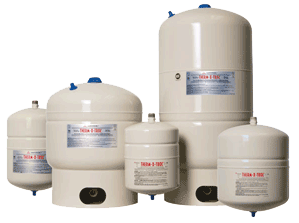
What Is a Water Heater Expansion Tank?
A water heater expansion tank is a small tank, typically located near or above your water heater, which serves to collect and store any expanded water due to increasing pressure when the water temperature is rising. This helps keep the pressure inside the water heater from rising too high and also reduces the amount of water that can be lost due to thermal expansion. This helps increase the efficiency and extend the life of your water heater and helps to prevent damage to your plumbing system.
Because water will expand when heated, the excess pressure inside the water heater tank needs to be released. In the past, the expanding water in the tank would simply drain back out into the municipal water supply where it came from. Today, the water main is designed to prevent the backwards release of pressure, known as backflow, by employing a check valve. The check valve prevents waste water from inside the house returning to the water supply where it can contaminate the supply of fresh water.
A water heater expansion tank is another small tank that is attached to the water supply pipe of the water heater. The expansion tank is designed to handle the thermal expansion of water as it heats up in the water heater, preventing excessive water pressure. If water pressure gets to high it can damage valves in plumbing fixtures, joints in supply pipes and the water heater itself. Expanding water from the water heater flows into the expansion tank, relieving water pressure in the system.
What if my water heater doesn't have an expansion tank?
Most homes that have a check valve on the water main do not have an expansion tank, since it wasn't required until recently. This may or may not cause excessive pressure buildup, depending on the specific design of the plumbing in the house.
If you are noticing that washers in plumbing fixtures are deteriorating rapidly, or water is dripping from the relief valve on the water heater, you may need add an expansion tank. It can be low cost insurance against more costly damage to your home's plumbing system. Grand Lake Plumbing and Heating can help you determine what kind of expansion tank is right for your water heater.
What to Do When Broken Glass Falls Into a Garbage Disposal
What to Do When Broken Glass Falls Into a Garbage Disposal

Breaking a glass in the sink while doing the dishes is a pretty common occurrence. Unfortunately, little bits of broken glass can fall into the garbage disposal, where they can be tricky to remove. It's important to turn off the disposal immediately when you hear and loud noises to prevent damaging the unit. The good news is that there are steps you can take to safely and effectively remove the broken glass so it does not end up being ground up in the disposal chamber. Here's how to remove the broken glass.
Safety First
Before attempting to remove the glass, it’s important to ensure the power to the disposal is turned off. Usually you can simply, unplug the disposal from the outlet located under the sink. If the unit can not be unplugged, you can turn off the power to the kitchen from the home's electrical panel by switching the circuit breaker to the "off" position.
Removing the Glass
To remove the glass you’ll need a pair of safety glasses and a pair of long-handled tongs or pliers. The safety glasses will protect your eyes from any flying glass, and the tongs will help you reach into the disposal to pull out the larger bits of glass.
Cleaning the Disposal
Once the larger bits of glass are out of the disposal, you will need to remove the smaller particles of glass. First, put on heavy rubber gloves to protect your hands. Next, take a damp sponge with a few drops of dish soap and carefully wipe the inside of the chamber to pick up the smaller glass particles. Once the chamber is as clean as possible, flush the disposal (power off) with warm water to dislodge any remaining fine glass particle.
When to Call a Plumber
If the glass has jammed in the impeller of the disposal, it is best to call a professional plumber. A plumber will have the tools and experience to safely and effectively remove the glass to prevent damaging the unit.
Plumbing For Hot Tubs
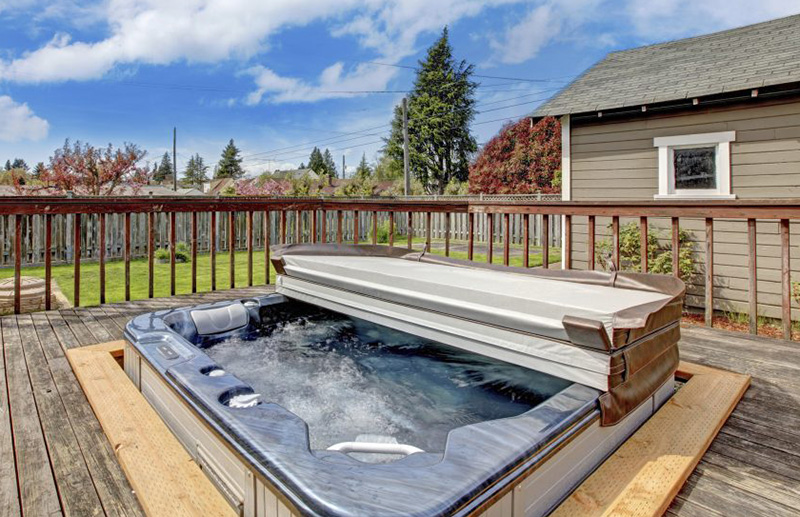
In the Colorado mountains, there are few things more luxurious than relaxing in a hot tub after a long day of winter activities. Hot tubs provide a spot to host family and friends, adding a wonderful mountain retreat vibe to your outdoor space. While having a hot tub can be fun, there are a few plumbing requirements you will need to consider in order to ensure it is installed safely and correctly.
First, your hot tub must be connected to a dedicated circuit breaker with a Ground Fault Circuit Interrupter (GFCI). This is a safety device that will shut off the power if there is an electrical fault. Second, you must have a dedicated shut-off valve for the hot tub. This will allow you to easily turn off the water supply to the hot tub if repairs are needed.
For the plumbing, you will need to have a dedicated water supply line to your hot tub. This will ensure that the hot tub is getting the right amount of water and pressure. A plumber will also need to install a dedicated waste line. This will allow the water to be safely drained away from the hot tub.
Do I need to hire a plumber to install a hot tub?
Yes, it is recommended that you hire a professional plumber to install your hot tub. A plumber will ensure that all of the necessary plumbing requirements are met. Hiring a plumber to install your hot tub will help you to avoid any potential issues and ensure your hot tub is installed correctly.
What are the plumbing considerations for installing a hot tub in a cold climate like Colorado?
There are a few additional plumbing considerations that must be taken into account. The water lines should be insulated to prevent them from freezing during the winter months. It's also recommended that a freeze protection timer be installed. The timer will turn the hot tub on and off automatically to prevent freezing.
How To Choose a New Water Heater
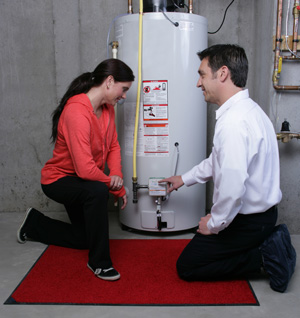
Has your old water heater stopped providing enough hot water? Does it show signs of corrosion or leaks? If so, it's time to start looking for a replacement. On average, a gas water heater will last around 8 years. With regular maintenance, which includes flushing the tank annually, you may be able to extend its lifespan to 12 years or more.
Choosing a new water heater
Here are the questions to consider when buying a new water heater:
- Will it be a gas or electric water heater?
- Do I want a tank-style water heater, or a tankless water heater?
- If it's a tank water heater, you will need to consider what capacity you will need
- What it the warranty?
- It's also important to consider efficiency, which you can find out by researching manufacturer websites
Consider Upgrading To a Tankless Water Heater
Tankless water heaters have several advantages over traditional tank-based models. The biggest advantage is that they provide a constant supply of hot water on demand, so you don't need to wait for the tank to refill. This makes tankless units a great option for large households that would otherwise need a very large water heater tank to avoid running out of hot warer.
Tankless systems are more energy efficient and have a longer lifespan than traditional water heaters. However, they are more complex and cost more to install, so make sure you factor this into your decision.
Once you have a general idea of what you need, your plumber can help you with other considerations, such as installation requirements, gas line connections, as well as any permits or inspections that may be required. They can also help select the best location for the water heater, such as near the kitchen or master bath.
Have questions about water heaters? Give Grand Lake Plumbing & Heating a call. We can help answer all your plumbing questions.
How Hard Water Can Cause Problems With Your Home's Plumbing System
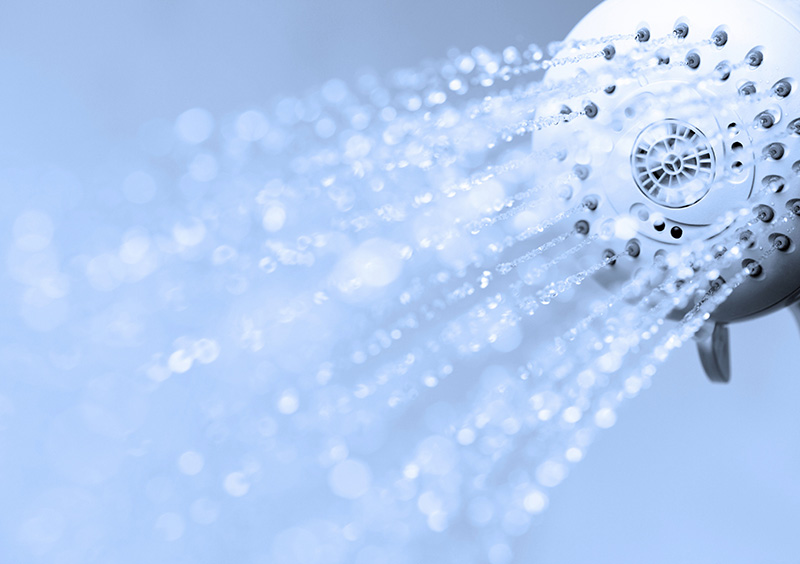
Hard water can cause problems for homeowners in both increased energy usage and a shortened lifespan of appliances. The two minerals most commonly found in hard water, calcium and magnesium, make heating water less efficient. It requires more energy to heat mineral heavy water compared to clear, purified water.
Hard water can also cause limescale build-up, drastically restricting the water flow in your pipes. Steel pipes are the most prone to this problem, copper and PVC are not as susceptible to limescale build up. Over time this scale build up can lower water pressure in your home's plumbing, eventually leading to costly damage to pipes and plumbing fixtures. As the flow in pipes becomes more restricted, the limescale buildup will happen at a faster rate.
The areas that you may first notice mineral build up are in areas around shower heads, plugs, faucets and valves. Slowly dripping faucets can cause scale build up on sink surfaces and could damage the rubber washers that are required to keep the mechanism water tight. If this occurs, the washers can sometimes be difficult to replace.
Hard Water and Appliance Damage
Hard water can damage many appliances in the home that use water, including washing machines, dishwashers, and ice makers. The minerals in hard water can cause scaling and clogging in the pipes, reducing the efficiency of the appliance and leading to costly repairs. Hard water can also reduce the lifespan of an appliance, increasing the need for frequent repairs or replacements.
Valves that are found in various appliances, such as ice-makers, washing machines and dishwashers can also end up with scale build-up. If small amounts of limescale build up around the valves, they may not be able to completely close, which can allow water to leak.
Water Heater Damage From Hard Water
Hard water can damage a water heater by leaving deposits of calcium and magnesium on the heating elements. Over time, these deposits will reduce the efficiency of the heater and eventually clog it. The deposits can also block the flow of water, creating additional strain on the heater and leading to premature failure.
Tankless water heaters can also be damaged by hard water. The minerals in hard water can cause scaling on the heat exchanger, reducing the efficiency of the unit and leading to costly repairs. Hard water can also shorten the lifespan of the unit and cause premature failure.
Water Softeners
The solution to hard water in the home is to install a water softener. A water softener removes dissolved minerals that can damage you home's plumbing system while also improving the quality of your home's water for cleaner, better tasting water.
Frequently Asked Questions About Home Sewer Lines
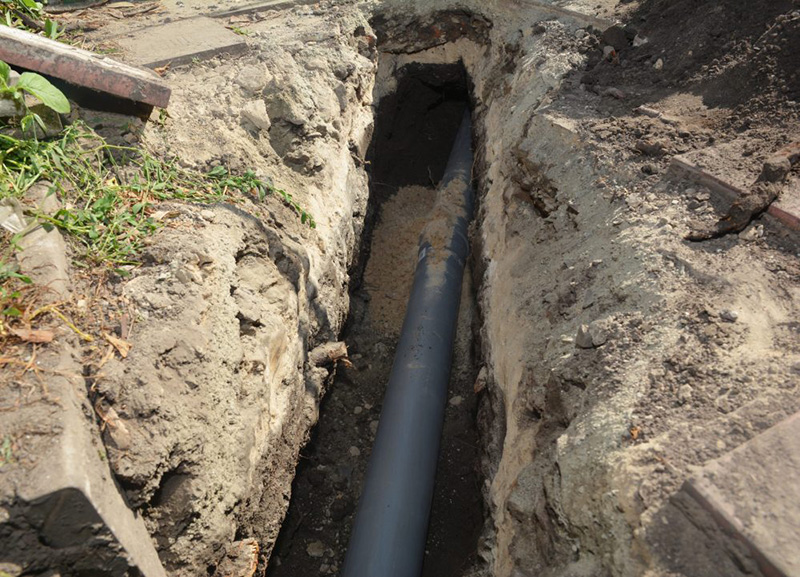
Many homeowners only think about their sewer line when there's a major problem. When problems do occur, there are many questions to consider. Here are some of the most common questions we receive from homeowners about their sewer lines.
How long will my sewer line last?
How long a sewer will last depends on a number of factors including the pipe material, proximity to trees, and the age of the plumbing system. If your sewer line is more than 40 years old, it may need replacing. Even if the home was built more recently, its plumbing may be connected to an older sewer pipe. Whatever the age of your home, having routine sewer and drain line inspections can give you peace of mind knowing that the system is working correctly. If problems are found, it's easier to fix the small problems before they become a major repair.
If the sewer line is damaged, who's responsible for fixing it?
In most municipalities, homeowners are responsible for maintaining the sewer line from the home to the sewer main. In most cases the sewer main is located under the street in residential areas.
Does homeowner's insurance cover sewer line damage and repair?
Most insurance policies do not cover repairs to sewer lines caused by age and wear and tear. We recommend checking your homeowner's insurance policy to see if it covers sewer pipe repair or replacement. Some insurance companies will add a sewer and drain endorsement to your policy to cover losses related to a sewer line backup, and resulting damage to property.
What causes sewer line damage?
The most common problem with older homes built prior to 1980 is damage from tree roots that have invaded the joints of the pipes. Once a pipe develops a small leak from a crack or loose joint, trees will seek out the nutrients inside the pipe and grow into the gaps, eventually obstructing the pipe. Other causes include acts of nature such as erosion, human-caused damage from digging too close to the pipe, and age related deterioration.
How can I prevent damage to my sewer line?
Even if your home is newer, regular video sewer line inspections are good insurance. By inspecting the pipes for bulges, joint failures, cracks and tree root intrusion, you can prevent a costly sewer line backup and extensive repairs.
My sewer line is damaged, what are my options?
In the past, your only option was to dig a trench in the yard to access to the damaged section of the pipe. With today's new trenchless sewer line repair technology, we can often repair a damaged sewer line from inside the line itself. After clearing the obscructed section of pipe we can reline the inside of the pipe from the inside to repair the damage.
Have questions about home sewer lines? Call Grand Lake Plumbing and Heating. We can help answer all your questions.
The Benefits of Whole Home Water Filtration

While Grand County is renowned for it's pristine lakes and rivers, there are a few common water quality issues that lead some residents to drink bottled water or look for ways to improve their home's drinking water. These include hard water where minerals create anunpleasant taste and water spotting, and well water contamination from organic material like e. coli bacteria and chemicals like arsenic.
Here are a few of the benefits of a whole-home water treatment system:
Safer Water
Reverse-osmosis water filtration systems are very effective at removing nitrates, lead, radium, arsenic, and other harmful contaminants.
Environmental Friendly Option
Quality home water treatment systems waste little water and have filters that last a long time before needing replacement. There is far less waste compared to buying bottled water.
Cost Effective
Even if you're drinking only two or three bottles of water a day, installing a whole-home water filtration system will quickly pay for itself.
Protects Your Plumbing
The minerals in hard water causes water heaters and plumbing fixtures to wear out faster. Purified water will prevent sediment build-up in water heater tanks and make clogged shower heads and faucets a thing of the past.
Cleaner Home
Hard water not only stains dishes and shower enclosures, it requires more detergent to effectively laundry and dishes. A water purification system will save time and money on cleaning and laundry.
If your concerned about your drinking water, call Grand Lake Plumbing and Heating. We can perform a water analysis and determine if there are water quality issues that could be improved with a whole home water filtration system.
Slab Leak Warning Signs

A slab leak causes water to collect underneath the foundation of a home. If left undetected for long enough, it can cause enough water to build up that it can damage the basement floor and foundation – the home's slab - by causing it to shift, leading to expensive structural damage.
Slab leaks can be caused by corrosion in the pipe itself, or from damage to the slab from cracks and settling.
Water Seeping From Under the home
If you notice water seeping from under the house, it's important to identify the cause as soon as possible. When a slab leak is suspected, the first step is to rule out other causes, such as leaks from toilets, faucets and other plumbing systems. Next a plumber will need to check the water supply and drain pipes that are inside the concrete slab for leaks.
High Water Bill
A common warning sign of a slab leak is an unexpectedly high water bill. Unless you have had additional guests or are running a sprinkler more often, don't ignore this warning sign. Have a plumber inspect your home as soon as possible.
Basement Wetness
This can resemble a spill on the floor or wet spots that have no apparent cause. Rule out other causes such as pipes leaking above, water heaters and water seepage from rainfall.
If you notice water on exterior walls and there is no obvious cause, like humidity or a sprinkler hitting the house, water from a slab leak could seeping from the inside out.
Cracks in Foundation
Because water under the slab can cause the foundation to shift, cracks may appear on basment floors or on exterior or interior walls.
If you notice any of the warning signs above it's important to have the plumbing system checked as soon as possible. Slab leaks can result in thousands of wasted gallons of water a year and significant damage to your home if left unchecked. Your plumber can check the entire home and eliminate any other causes to determine if a slab leak is present. If problems are found, the water can be turned off and repairs can be performed to prevent further damage.
Preventing Mold Caused By Plumbing Problems
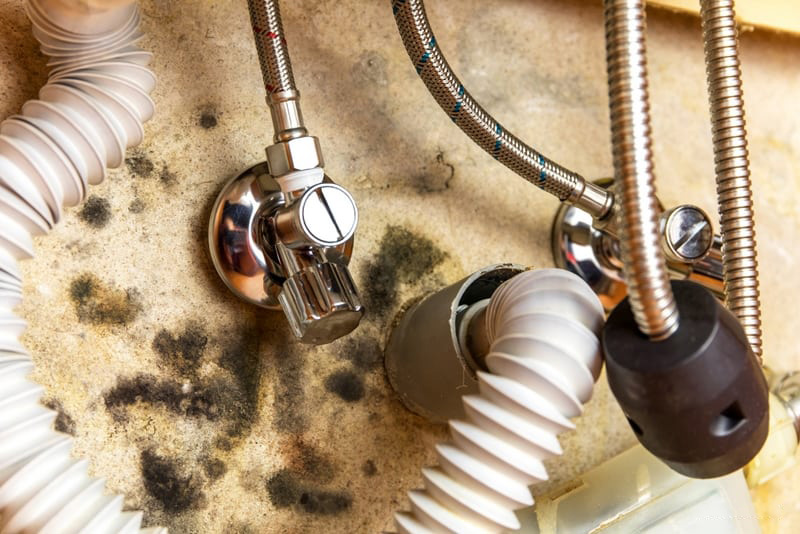
Having mold and mildew growth inside the home can be harmful to your health. Mold can cause allergies and a host of other conditions, including asthma attacks, skin and eye irritation as well as upper respiratory irritation. Mold grows to unhealthy levels when tiny airborne spores land in damp or humid areas of the home that never completely dry out. This moisture is usually cause by structural problems with the home that allow water inside, such as a leaking roof, poor ventilation, or plumbing leaks.
Sources of Mold From Plumbing
Sinks
The cabinets under sinks are a common place for mold and mildew to take hold. Even a small leak inside a small, enclosed space can lead to unsafe levels of mold. The problem often goes undetected because the cabinets are used to store cleaning supplies and other materials that prevent the mold from being seen. If you notice any mold under your sink, thoroughly clean the area with diluted chlorine bleach and have any leaks from valves, supply lines or drains repaired to prevent water from seeping underneath.
Clogged Drains
Clogs in drains can lead to mold growth inside the drain, as well as in the surrounding area when water overflows and is not thoroughly cleaned up.
Standing Water
Standing water in basements can be caused by clogged floor drains, a sump pump that is not working, leaking water heaters and leaking or dripping pipes. Have leaking water heaters and sump pumps repaired or replaced and ensure that any materials that may have been contaminated by mold are safely disposed of.
Bathroom Humidity
Because high humidity and some standing water is unavoidable in bathrooms, the key is proper ventilation and cleaning up excess water on floors. If possiblem, open windows in bathrooms or have a high capacity ventilation fan installed.
Hidden Leaks
Leaks inside walls can go undetected for years. By the time they are noticed , significant mold has grown inside the walls, requiring extensive repairs. The key is to take action when you first notice any sign of trouble. This includes water stains on walls or ceilings, dripping sounds, or un unusually high water bill.
If you're concerned about plumbing leaks leading to mold growth in your home, call Grand Lake Plumbing. We can inspect your home and repair any problems that could lead to harmful mold growth.
What's Performed During a Plumbing Inspection?
What's Performed During a Plumbing Inspection?

Whether you're buying a home or having your current home checked for problems, an examination of the plumbing system is a critical part of any home inspection. While different home inspectors will use various checklist, There are the critical items that are always part of the list. While some checks should only be performed by a qualified plumber or home inspector, as a homeowner, you can perform some of these checks yourself, By inspecting your plumbing you can find the little problems before they lead to expensive system failures or water damage.
Check the functioning of the main water supply valve. When the valve has been closed for a while with no plumbing fixtures being used. Check the water meter. If the meter has continued to run it often indicates a leak somewhere in the supply lines.
It's also good idea to label the valve as "emergency water shut-off" and include instructions for the direction to turn the valve.
Examine plumbing fixtures, supply lines, and drains to ensure the system is watertight. Fill the entire drainage systems with water to the middle of a trip waste overflow of every tub installed to validate if plumbing systems are closely sealed.
Pressure test the piping. Ensure normal working pressure as water is passing through the water pipes. The water supply should run smoothly even at the minimum water pressure requirement. Ensure there is no air in the pipes or banging (water hammer) when operating plumbing systems.
Check the sewer and drainage lines. Assess the sewer lines from property to the main sewer line connection or septic tank. Inspect drainage systems for clogs, pipe damage or excessive corrosion. Perform a video inspection inside the drain and sewer lines to look for pipe damage such as cracks, clogs and tree root intrusion.
Inspect the sump pump. Ensure the pump is not obstructed or excessively dirty. Clear out any debris from the sump pump pit and fill the pit with water. The pump should automatically turn on and remove the water.
Make sure all fixtures have a separate valve to control the water supply.
Check for signs of water damage inside and outside the home. Check exterior drainage, including gutters, flexible hoses, and drains for obstructions that could affect plumbing systems or cause water intrusion into the homeowner.
In homes with a well, check the pressure valve for correct pressure and inspect the well tank for leaks or excessive corrosion. Ensure the well pump is operating correctly and not cycling on/off continuously or too frequently.
Signs Your Well Needs Service
Signs Your Water Well Needs Service
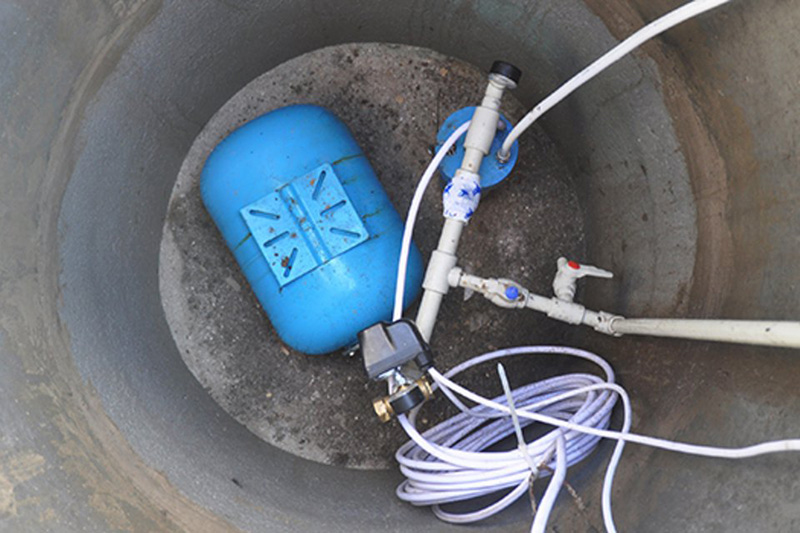
Many homes in Grand County area rely on private wells to supply water for drinking, bathing, cooking, and other uses. An electric pump is used to bring the water from the ground and store several gallons of water in a pressure tank, or well water tank. If the tank loses pressure, it can cause the pump to cycle on and off more frequently. This can lead the pump to fail prematurely, requiring a costly replacement.
Here are the symptoms of a well water tank that is malfuctioning:
- The tank’s pressure gauge indicates low pressure
- The pump cycles on and off frequently
- The pump is running continually
- You are experiencing lower water pressure, especially at fixtures further away from the tank
- Water pressure fluctuated when the pump cycles on and off
- The pump runs less than 30 seconds to pressurize the tank
- You can see water leaks at the pressure tank
- There is visible corrosion on the exterior of the tank
- You notice air in plumbing system when faucets are used
Any of the above symptom may indicate that the well water tank is leaking or its bladder has failed. To prevent damage to the well pump, it's important to have the tank inspected as soon as possible. If leaks are detected the tank should be replaced. Call Grand Lake Plumbing and Sweet Water Pump. Our professional plumbers will inspect the well, diagnose any problems and recommend repairs if needed
.
Signs Your Plumbing System Is Poorly Vented
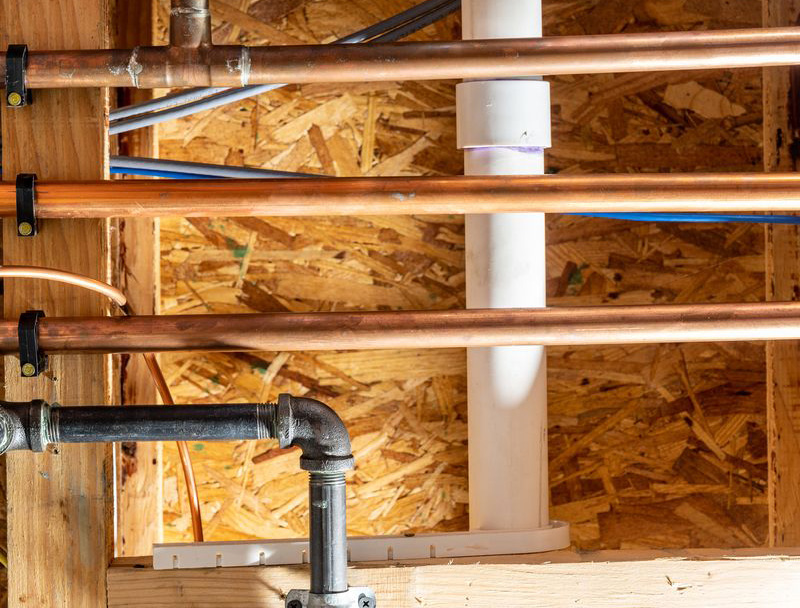
In order for water to flow freely through your home's plumbing system air must be drwan into the pipe to fill the space that's left behind the flow of water as it moves through the pipe. To accomplish this a plumbing system needs to be vented. Because the air needs to enter at a level higher than the water, pipes are run through the roof of the house to allow air to enter the system.
When a plumbing system is not venting correctly, it's often because there's a obstruction in the roof vent. For example, there may be ice accumulation or a bird's nest obstructing the vent pipe. In some cases, faulty venting can occur during a repair or remodeling project when a retrofit is made without understanding how the plumbing system works.
Here are some symptoms you may notice if your home's plumbing system is not vented correctly.
The Toilet Is Bubbling
While air bubbles in the toilet bowl a symtom of a clog, they can also be a sign that the toilet is not fully vented. You may notice that the toilet only bubbles when the washer is working, this is because the washer is draining and preventing the air from reaching the toilet.
The Water Level Is Inconsistent
Is the water level in the toilet inconsistent? If drain lines are not vented correctly water exiting the drains will pull water from the toilet P-trap. It's best to have a plumber inspect the drain first. If the drains are working and there's no clog, then the venting system should be checked for an obstruction.
-
"Thank you for the service. I want to let you know the technician Sawyer was professional, thorough and fixed our problem in less than 1 hour. I will recommend GL Plumbing to others."– L.M. 10/25/16
- 1
- 2
- 3
Communities We Serve
Grand Lake CO 80447
Granby CO 80446
Hot Sulphur Springs CO 80451
Kremmling CO 80459
Parshall CO 80468
Tabernash CO 80478
Winter Park CO 80482
And Many More Communities In Western Colorado

